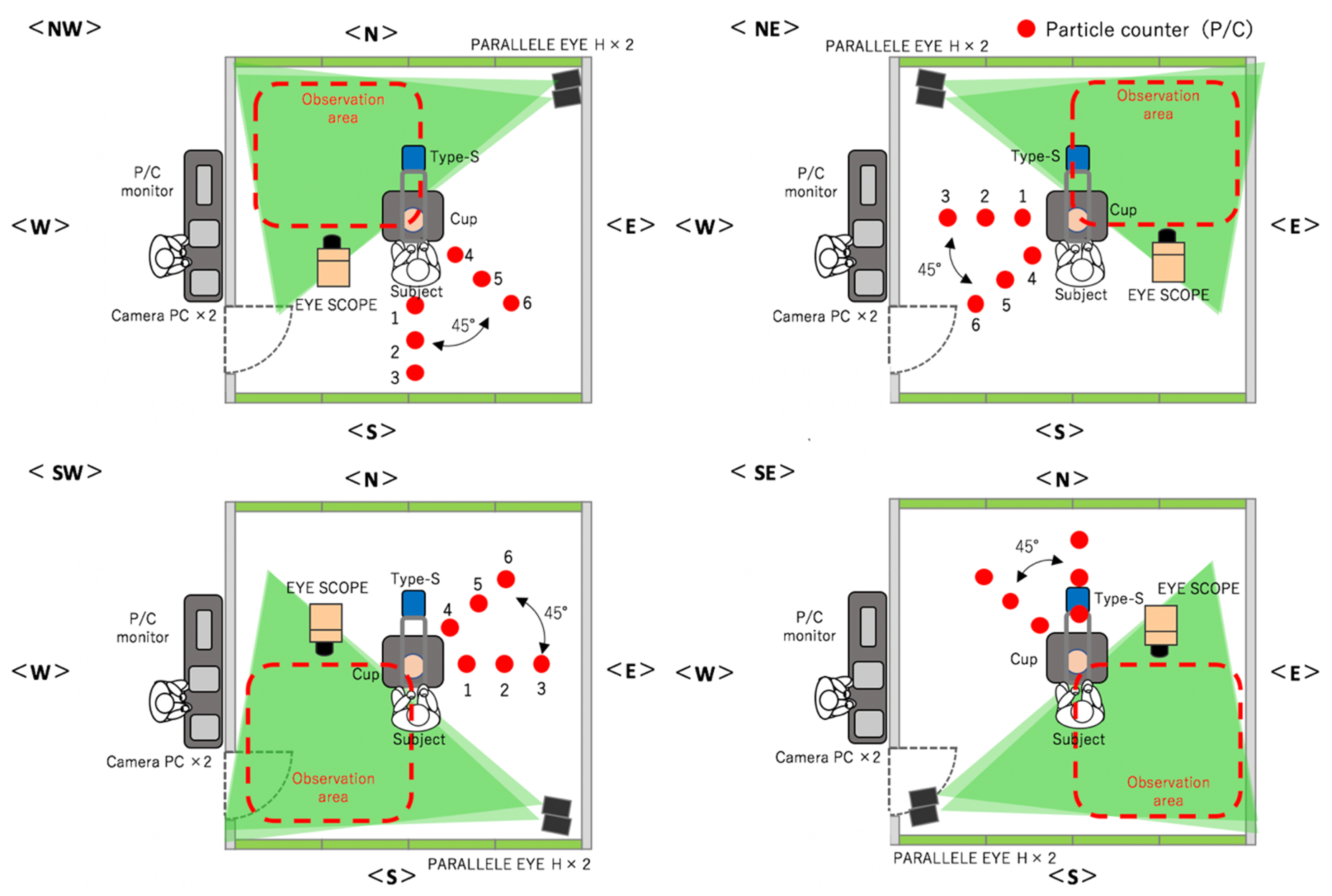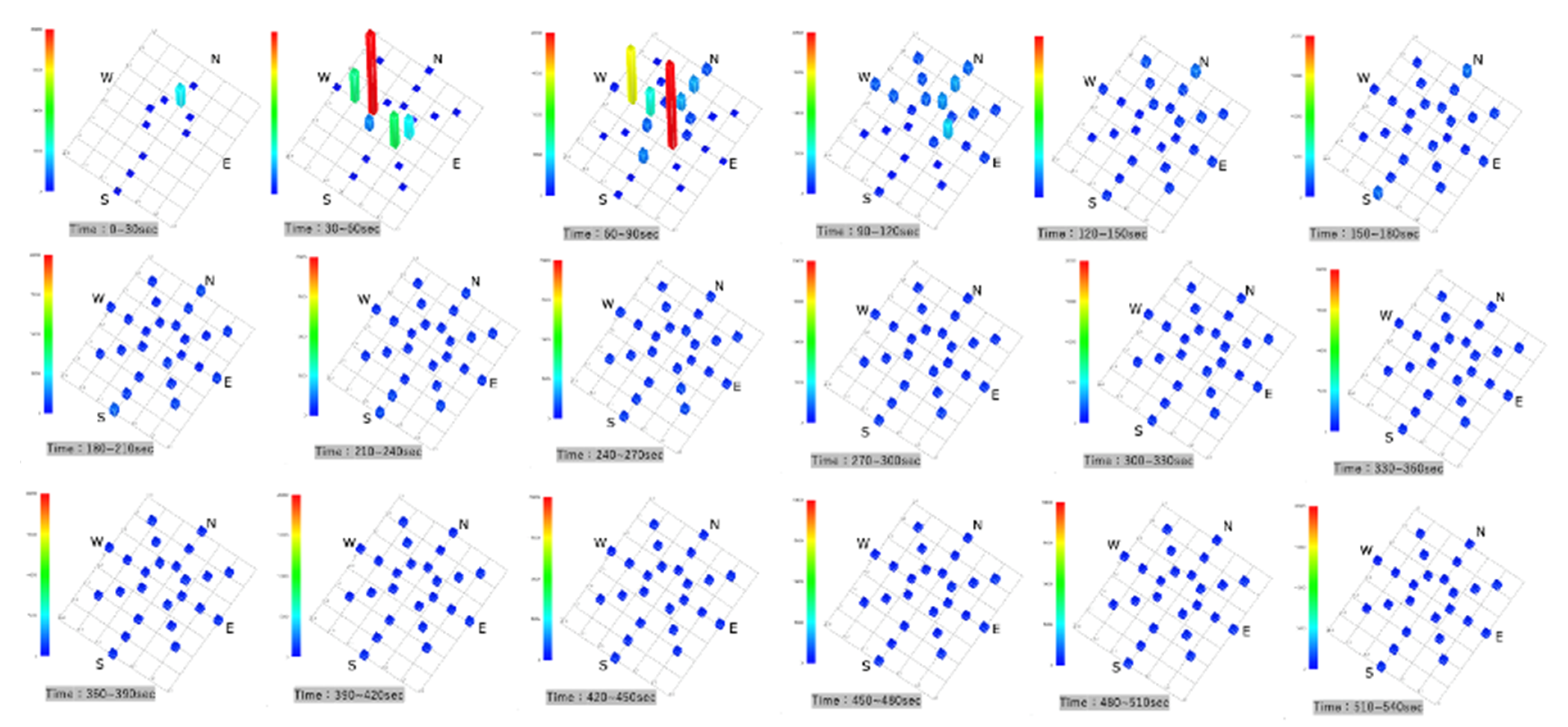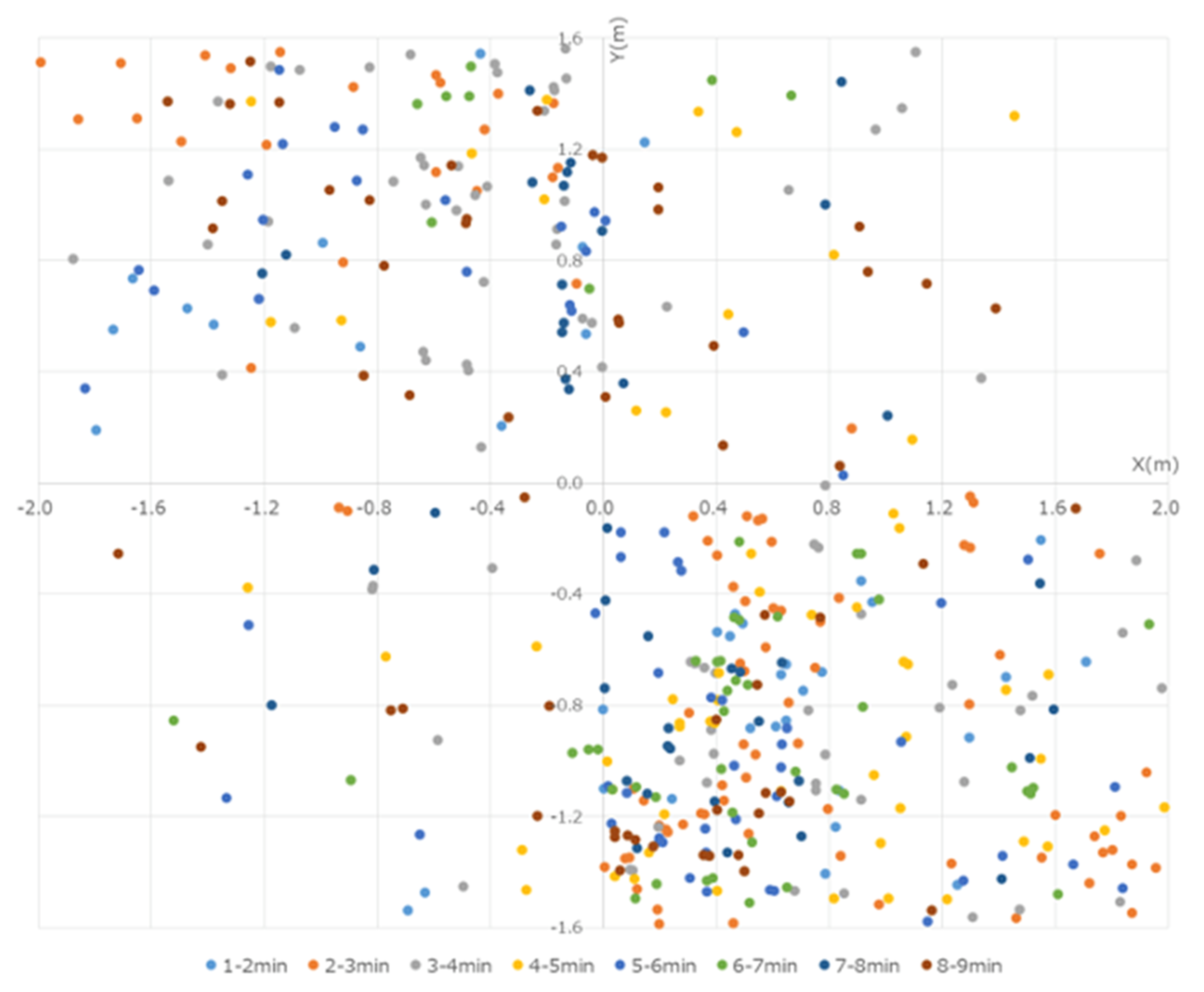Dispersion of Aerosols Generated during Dental Therapy
Abstract
:1. Introduction
2. Materials and Methods
Aerosol Particle Scattering Experiment
- Measurement of the aerosol particles immediately over the table. A visualization coefficient device called Type-S (sensing area: 4 × 20 cm; Shin Nippon Air Technologies) was set up at a location that was 60 cm above the table (position of the head of a worker). The number of particles that were larger than 0.5 µm and passed through was measured continuously for 9 min, and sampling was performed in 1/30 s intervals.
- Qualitative assessment of the distribution of droplets using a visualization video. Two scanning laser sheet light sources (Parallel Eye H, Shin Nippon Air Technologies) were used to create a 2 × 2 m laser sheet at a location that was 30 cm from the floor. Traversing droplets were monitored continuously for 9 min with a microparticle-visualizing high-sensitivity camera called i-Scope for the distribution of the transiting particles that were larger than 5 µm, and 30 s still images were continuously created. The basic image processing software package ParticleEye Viewer (Shin Nippon Air Technologies) was used for image processing to obtain the visualized accumulated images of the horizontal cross-section. Because the instrument setup and sensitivity issues made it impossible to measure the entire region inside the SCL simultaneously, the SCL was divided into four areas, and the experiment was performed three times each at position. The median values of these three experiments were used in the following data analysis (Figure 1).
- Quantitative assessment of the droplet distribution by counting. P/Cs (TSI Model 9303 with a suction flow rate of 2.83 L/min, and Particle Plus Model P311 with a suction flow rate of 2.83 L/min) were used to capture the particles. The P/Cs measured the aerosol particles’ size, quantity, and the amount of settled particles over time. Six P/Cs were used in each area and were set up in 50 cm intervals in the 90° direction (1–3) and 45° direction (3–6) at the same height as the workbench (74 cm from the floor). This approach was used to capture the settled particles and to measure the distribution of dispersion. Particles with a grain size of >0.5 μm or >5.0 μm were measured continuously for 9 min, with a sampling duration of 10 s intervals.
3. Results
4. Discussion
5. Conclusions
Author Contributions
Funding
Institutional Review Board Statement
Informed Consent Statement
Data Availability Statement
Acknowledgments
Conflicts of Interest
References
- Chan, J.F.W.; Yuan, S.; Kok, K.H.; To, K.K.; Chu, H.; Yang, J.; Xing, F.; Liu, J.; Yip, C.C.Y.; Poon, R.W.S.; et al. A familial cluster of pneumonia associated with the 2019 novel coronavirus indicating person-to-person transmission: A study of a family cluster. Lancet 2020, 395, 514–523. [Google Scholar] [CrossRef] [Green Version]
- Huang, C.; Wang, Y.; Li, X.; Ren, L.; Zhao, J.; Hu, Y.; Zhang, L.; Fan, G.; Xu, J.; Gu, X.; et al. Clinical features of patients infected with 2019 novel coronavirus in Wuhan, China. Lancet 2020, 395, 497–506. [Google Scholar] [CrossRef] [Green Version]
- Li, Q.; Guan, X.; Wu, P.; Wang, X.; Zhou, L.; Tong, Y.; Ren, R.; Leung, K.S.M.; Lau, E.H.Y.; Wong, J.Y.; et al. Early transmission dynamics in Wuhan, China, of novel coronavirus-infected pneumonia. N. Engl. J. Med. 2020, 382, 1199–1207. [Google Scholar] [CrossRef] [PubMed]
- Ong, S.W.X.; Tan, Y.K.; Chia, P.Y.; Lee, T.H.; Ng, O.T.; Wong, M.S.Y.; Marimuthu, K. Air, surface environmental, and personal protective equipment contamination by severe acute respiratory syndrome coronavirus 2 (SARS-CoV-2) from a symptomatic patient. JAMA 2020, 323, 1610–1612. [Google Scholar] [CrossRef] [Green Version]
- World Health Organization. Infection Prevention and Control during Health Care When COVID-19 Is Suspected 2020. Available online: https://www.who.int/publications/i/item/10665-331495 (accessed on 15 May 2021).
- Azzi, L.; Carcano, G.; Gianfagna, F.; Grossi, P.; Gasperina, D.D.; Genoni, A.; Fasano, M.; Sessa, F.; Tettamanti, L.; Carinci, F.; et al. Saliva is a reliable tool to detect SARS-CoV-2. J. Infect. 2020, 81, e44–e50. [Google Scholar] [CrossRef] [PubMed]
- To, K.K.; Tsang, O.T.Y.; Yip, C.C.Y.; Chan, K.H.; Wu, T.C.; Chan, J.M.C.; Leung, W.S.; Chik, T.S.H.; Choi, C.Y.C.; Kandamby, D.H.; et al. Consistent detection of 2019 novel coronavirus in saliva. Clin. Infect. Dis. 2020, 71, 841–843. [Google Scholar] [CrossRef] [PubMed] [Green Version]
- Wax, R.S.; Christian, M.D. Practical recommendations for critical care and anesthesiology teams caring for novel coronavirus (2019-nCoV) patients. Can. J. Anaesth. 2020, 67, 568–576. [Google Scholar] [CrossRef] [PubMed] [Green Version]
- Xian, P.; Xu, X.; Li, Y.; Cheng, L.; Zhou, X.; Ren, B. Transmission routes of 2019-nCoV and controls in dental practice. Int. J. Oral Sci. 2020, 12, 9. [Google Scholar]
- Xu, H.; Zhong, L.; Deng, J.; Peng, J.; Dan, H.; Zeng, X.; Li, T.; Chen, W. High expression of ACE2 receptor of 2019-nCoV on the epithelial cells of oral mucosa. Int. J. Oral Sci. 2020, 12, 8. [Google Scholar] [CrossRef] [PubMed]
- Guerra, F.; Mata, A.D.; Palma, P.; Chaves, C.; Vinagre, A.; Costa, A.L.; Vieira, A.L.; Falcão, C.; Chaves, C.; Herrera, D. COVID-19-Clinical Guidelines Dentistry; Coimbra University Press: Coimbra, Portugal, 2020; ISBN 13(15)978-989-26-2072-5. [Google Scholar] [CrossRef]
- Gallagher, J.E.; Sukriti, K.C.; Johnson, I.G.; AL-Yaseen, W.; Jones, R.; McGregor, S.; Robertson, M.; Harris, R.; Innes, N.; Wade, W.G. A systematic review of contamination (aerosol, splatter and droplet generation) associated with oral surgery and its relevance to COVID-19. BDJ Open 2020, 6, 1–17. [Google Scholar] [CrossRef] [PubMed]
- Innes, N.; Johnson, I.G.; Al-Yaseen, W.; Harris, R.; Jones, R.; Kc, S.; McGregor, S.; Robertson, M.; Wade, W.G.; Gallagher, J.E. A systematic review of droplet and aerosol generation in dentistry. J. Dent. 2021, 105, 103556. [Google Scholar] [CrossRef] [PubMed]
- Ceisel, R.J.; Osetek, E.M.; Turner, D.W.; Spear, P.G. Evaluating chemical inactivation of viral agents in hand piece splatter. J. Am. Dent. Assoc. 1995, 126, 197–202. [Google Scholar] [CrossRef]
- Tamazawa, K.; Tamazawa, Y.; Shimauchi, H. Airborne contamination in the dental operating room. Jpn. J. Med. Instrum. 2014, 84, 537–542. [Google Scholar]
- Rexhepi, I.; Mangifesta, R.; Santilli, M.; Guri, S.; Di Carlo, P.; D’Addazio, G.; Caputi, S.; Sinjari, B. Effects of Natural Ventilation and Saliva Standard Ejectors during the COVID-19 Pandemic: A Quantitative Analysis of Aerosol Produced during Dental Procedures. Int. J. Environ. Res. Public Health 2021, 18, 7472. [Google Scholar] [CrossRef]
- Bentley, C.D.; Burkhart, N.W.; Crawford, J.J. Evaluating spatter and aerosol contamination during dental procedures. J. Am. Dent. Assoc. 1994, 125, 579–584. [Google Scholar] [CrossRef]
- Fukazawa, Y.; Nishida, M.; Morimoto, M. A new method employing a laser for observation of dental dust scattering. J. Dent. Health 1986, 36, 215–227. [Google Scholar] [CrossRef]
- Chen, N.; Zhou, M.; Dong, X.; Qu, J.; Gong, F.; Han, Y.; Qiu, Y.; Wang, J.; Liu, Y.; Wei, Y.; et al. Epidemiological and clinical characteristics of 99 cases of 2019 novel coronavirus pneumonia in Wuhan, China: A descriptive study. Lancet 2020, 395, 507–513. [Google Scholar] [CrossRef] [Green Version]
- Chia, P.Y.; Coleman, K.K.; Tan, Y.K.; Ong, S.W.X.; Gum, M.; Lau, S.K.; Sutjipto, S.; Lee, P.H.; Son, T.T.; Young, B.E.; et al. Detection of air and surface contamination by severe acute respiratory syndrome coronavirus 2 (SARS-CoV-2) in hospital rooms of infected patients. Nat. Commun. 2020, 11, 1–7. [Google Scholar] [CrossRef]
- Liu, Y.; Ning, Z.; Chen, Y.; Guo, M.; Liu, Y.; Gali, N.K.; Sun, L.; Duan, Y.; Cai, J.; Westerdahl, D.; et al. Aerodynamic analysis of SARS-CoV- 2 in two Wuhan Hospitals. Nature 2020, 582, 557–560. [Google Scholar] [CrossRef]
- Van Doremalen, N.; Morris, D.H.; Holbrook, M.G.; Gamble, A.; Williamson, B.N.; Tamin, A.; Harcourt, J.L.; Thornburg, N.J.; Gerber, S.I.; Lloyd-Smith, J.O.; et al. Aerosol and surface stability of SARS-CoV-2 as compared with SARS-CoV-1. N. Engl. J. Med. 2020, 382, 1564–1567. [Google Scholar] [CrossRef]
- Stephen, K.; Harrel, D.D.S.; Molinari, J. Aerosols and splatter in dentistry A brief review of the literature and infection control implication. JADA 2004, 135, 429–437. [Google Scholar]
- Shahdad, S.; Patel, T.; Hindocha, A.; Cagney, N.; Mueller, J.D.; Seoudi, N.; Morgan, C.; Din, A. The efficacy of an extraoral scavenging device on reduction of splatter contamination during dental aerosol generating procedures: An exploratory study. Br. Dent. J. 2020, 1–10. [Google Scholar] [CrossRef]
- Sinjari, B.; Rexhep, I.; Santilli, M.; D’Addazio, G.; Chiacchiaretta, P.; di Carlo, P.; Caputi, S. The Impact of COVID-19 Related lockdown on Dental Practice in Central Italy—Outcomes of a Survey. Int. J. Environ. Res. Public Health 2020, 17, 5780. [Google Scholar] [CrossRef] [PubMed]
- Butera, A.; Maiorani, C.; Natoli, V.; Bruni, A.; Coscione, C.; Magliano, G.; Giacobbo, G.; Morelli, A.; Moressa, S.; Scribante, A. Bio-Inspired Systems in Nonsurgical Periodontal Therapy to Reduce Contaminated Aerosol during COVID-19: A Comprehensive and Bibliometric Review. J. Clin. Med. 2020, 9, 3914. [Google Scholar] [CrossRef]
- Clementini, M.; Raspini, M.; Barbato, L.; Bernardelli, F.; Braga, G.; di Gioia, C.; Littarru, C.; Oreglia, F.; Brambilla, E.; Iavicoli, I.; et al. Aerosol transmission for SARS-CoV-2 in the dental practice. A review by SIdP Covid-19 task-force. Oral Dis. 2020. [Google Scholar] [CrossRef]
- Ehtezazi, T.; Evans, D.G.; Jenkinson, I.D.; Evans, P.A.; Vadgama, V.J.; Vadgama, J.; Jarad, F.; Grey, N.; Chilcott, R.P. SARS-CoV-2: Characterisation and mitigation of risks associated with aerosol generating procedures in dental practices. Br. Dent. J. 2020, 13. [Google Scholar] [CrossRef]
- Chin, A.W.H.; Chu, J.T.S.; Perera, M.R.A.; Hui, K.P.Y.; Yen, H.-L.; Chan, M.C.W.; Peiris, M.; Poon, L.L.M. Stability of SARS-CoV-2 in different environmental conditions. Lancet Microbe 2020, 1, e10. [Google Scholar] [CrossRef]
- Mizukoshi, A.; Nakama, C.; Okumura, J.; Azuma, K. Assessing the risk of COVID-19 from multiple pathways of exposure to SARS-CoV-2: Modeling in health-care settings and effectiveness of nonpharmaceutical interventions. Environ. Int. 2021, 147, 106338. [Google Scholar] [CrossRef]
- Chu, D.K.; Akl, E.A.; Duda, S.; Solo, K.; Yaacoub, S.; Schunemann, H.J. Physical distancing, face masks, and eye protection to prevent person-to-person transmission of SARS-CoV-2 and COVID-19: A systematic review and meta-analysis. Lancet 2020, 395, 1973–1987. [Google Scholar] [CrossRef]
- Wei, J.; Li, Y. Airborne spread of infectious agents in the indoor environment. Am. J. Infect. Control 2016, 44, 102–108. [Google Scholar] [CrossRef]
- World Health Organization. Report of the WHO-China Joint Mission on Coronavirus Disease 2019 (COVID-19); World Health Organization: Geneva, Switzerland, 2020; Available online: https://www.who.int/publications/i/item/report-of-the-who-china-joint-mission-on-coronavirus-disease-2019-(covid-19) (accessed on 15 May 2021).




| Light sources | Two scanning laser sheet light sources (“Parallel Eye H”) |
| Cameras | One specialized microparticle-visualizing high-sensitivity camera (“i-Scope”) |
| Image processing | The basic image processing software package “ParticleEye Viewer” |
| Particle measurement | One mobile visualizing counter system (“Type-S”) Two types of particle counters (Six units in total) A: Particle Plus model P311 (four units) B: TSI model AeroTrak9110 (two units) |
Publisher’s Note: MDPI stays neutral with regard to jurisdictional claims in published maps and institutional affiliations. |
© 2021 by the authors. Licensee MDPI, Basel, Switzerland. This article is an open access article distributed under the terms and conditions of the Creative Commons Attribution (CC BY) license (https://creativecommons.org/licenses/by/4.0/).
Share and Cite
Takanabe, Y.; Maruoka, Y.; Kondo, J.; Yagi, S.; Chikazu, D.; Okamoto, R.; Saitoh, M. Dispersion of Aerosols Generated during Dental Therapy. Int. J. Environ. Res. Public Health 2021, 18, 11279. https://doi.org/10.3390/ijerph182111279
Takanabe Y, Maruoka Y, Kondo J, Yagi S, Chikazu D, Okamoto R, Saitoh M. Dispersion of Aerosols Generated during Dental Therapy. International Journal of Environmental Research and Public Health. 2021; 18(21):11279. https://doi.org/10.3390/ijerph182111279
Chicago/Turabian StyleTakanabe, Yusuke, Yutaka Maruoka, Junko Kondo, Shotaro Yagi, Daichi Chikazu, Ryuta Okamoto, and Masao Saitoh. 2021. "Dispersion of Aerosols Generated during Dental Therapy" International Journal of Environmental Research and Public Health 18, no. 21: 11279. https://doi.org/10.3390/ijerph182111279
APA StyleTakanabe, Y., Maruoka, Y., Kondo, J., Yagi, S., Chikazu, D., Okamoto, R., & Saitoh, M. (2021). Dispersion of Aerosols Generated during Dental Therapy. International Journal of Environmental Research and Public Health, 18(21), 11279. https://doi.org/10.3390/ijerph182111279





